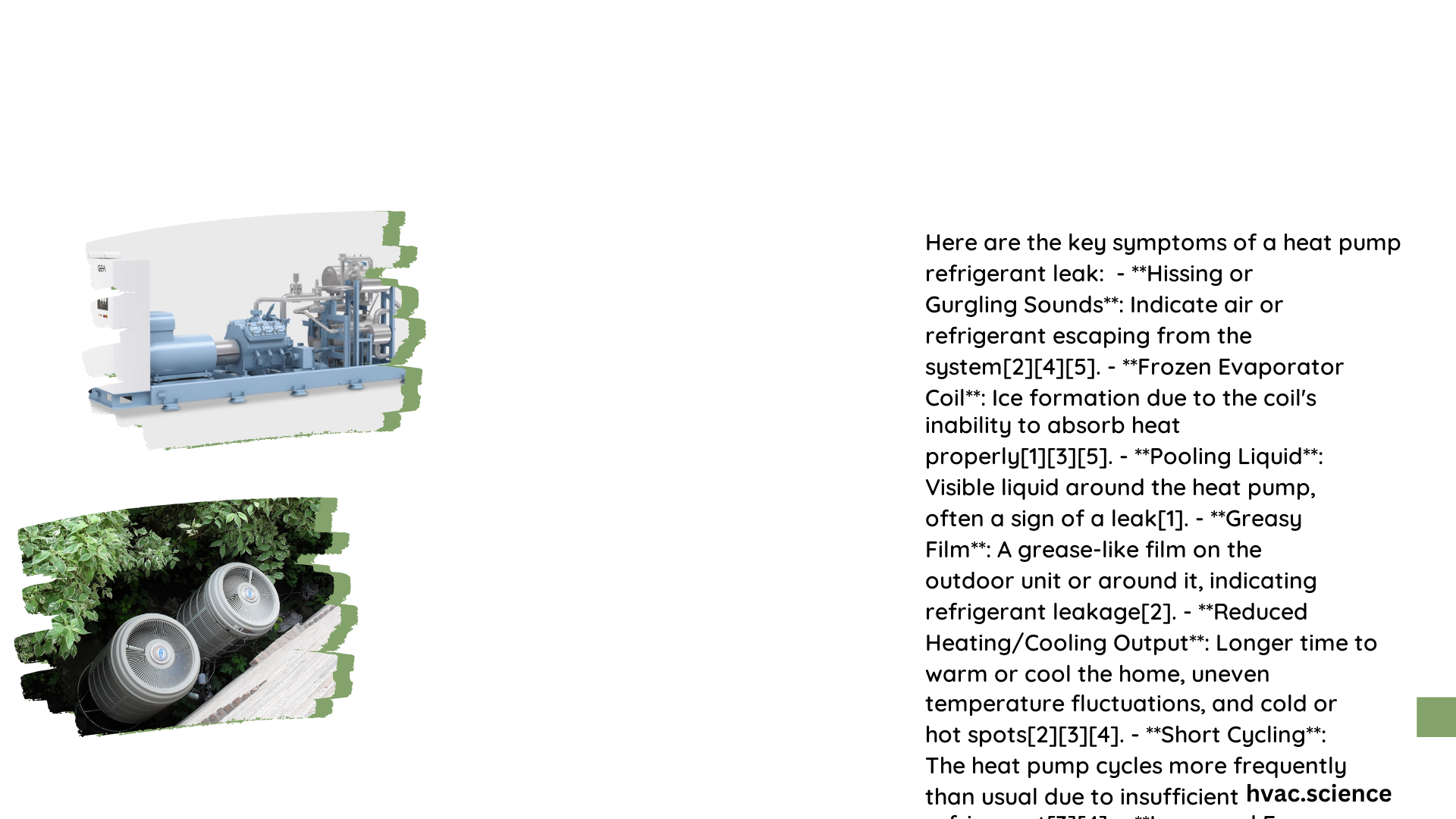Heat pump refrigerant leak symptoms include temperature fluctuations, reduced efficiency, ice formation on evaporator coils, and increased energy bills. Other signs are uneven heating or cooling, high humidity levels, and short cycling. Visual indicators like a greasy film on the outdoor unit can also suggest a leak. Unusual noises such as hissing or bubbling sounds may indicate escaping refrigerant.
What Are the Primary Indicators of a Heat Pump Refrigerant Leak?
Heat pump refrigerant leaks can significantly impact the performance and efficiency of your HVAC system. Recognizing the symptoms early can help prevent further damage and costly repairs. Here are the main indicators to watch out for:
- Temperature Inconsistencies
- Reduced Heating or Cooling Efficiency
- Increased Energy Consumption
- Visible Ice Formation
- Unusual Noises
Let’s delve deeper into each of these symptoms to help you identify potential refrigerant leaks in your heat pump system.
How Do Temperature Fluctuations Indicate a Refrigerant Leak?

One of the most noticeable heat pump refrigerant leak symptoms is temperature inconsistency throughout your home. When your heat pump lacks sufficient refrigerant, it struggles to maintain the desired temperature. This can manifest in several ways:
- Weak heating or cooling output
- Longer time to reach the set temperature
- Uneven heating or cooling (hot or cold spots in different rooms)
- Warm air blowing when cooling, or cool air when heating
These temperature fluctuations occur because the refrigerant is crucial for heat transfer. Without enough refrigerant, the heat pump can’t effectively move heat in or out of your home, leading to inconsistent temperatures.
What Visual Clues Suggest a Refrigerant Leak?
Visual indicators can be valuable in identifying a refrigerant leak. Here are two key visual clues to look out for:
-
Ice Formation: Check the evaporator coils of your heat pump. If you notice ice buildup, it could indicate a refrigerant leak. The coils need refrigerant to absorb heat effectively. Without sufficient refrigerant, moisture in the air can freeze on the coils.
-
Greasy Film: Inspect the outdoor unit of your heat pump and the area around it. A greasy film or oily residue can be a sign of leaking refrigerant. This occurs because refrigerant turns into a liquid at room temperature and can leave a greasy trace.
Why Do Energy Bills Increase with a Refrigerant Leak?
A refrigerant leak often leads to a noticeable increase in your energy bills. This happens for several reasons:
-
Reduced Efficiency: With less refrigerant, your heat pump has to work harder to achieve the desired temperature, consuming more energy in the process.
-
Longer Run Times: The system may need to operate for extended periods to maintain comfort levels, leading to increased energy usage.
-
Compressor Strain: Low refrigerant levels can put extra stress on the compressor, causing it to draw more power.
To illustrate the impact, consider this comparison:
| Condition | Energy Consumption | Efficiency |
|---|---|---|
| Normal Operation | Baseline | 100% |
| Minor Leak | 10-20% increase | 80-90% |
| Significant Leak | 30-50% increase | 50-70% |
What Other Symptoms Might Indicate a Refrigerant Leak?
Beyond the primary indicators, there are several other symptoms that could suggest a refrigerant leak in your heat pump:
-
High Humidity Levels: A properly functioning heat pump helps dehumidify your home. If you notice increased humidity, it could be due to a refrigerant leak affecting the system’s dehumidification capabilities.
-
Short Cycling: This occurs when your heat pump turns on and off more frequently than normal. Low refrigerant levels can cause the system to shut off prematurely, leading to short cycling.
-
Hissing or Bubbling Sounds: Unusual noises can be telltale signs of a refrigerant leak.
- Hissing sounds indicate refrigerant escaping as a gas
-
Bubbling noises suggest liquid refrigerant leaking
-
Weak Airflow: If you notice reduced airflow from your vents, it could be due to insufficient refrigerant affecting the system’s ability to circulate air effectively.
How Can You Detect a Refrigerant Leak in Your Heat Pump?
While some symptoms of a refrigerant leak are noticeable to homeowners, precise detection often requires professional tools and expertise. Here are some methods used to detect refrigerant leaks:
-
Visual Inspections: Professionals can spot signs like oil residue or corrosion that might indicate a leak.
-
Electronic Leak Detectors: These highly accurate devices can identify the presence of refrigerant in the air.
-
Soap Bubble Tests: A simple method where a soap solution is applied to suspected leak areas. If bubbles form, it indicates a leak.
-
UV Dye Methods: UV dye is injected into the refrigerant system, and a UV light is used to detect the dye at the leak site.
What Should You Do If You Suspect a Refrigerant Leak?
If you notice any of the heat pump refrigerant leak symptoms mentioned above, it’s crucial to take prompt action:
- Turn off your heat pump to prevent further damage.
- Ventilate the area to avoid inhaling refrigerant fumes.
- Contact a certified HVAC technician for a professional inspection and repair.
Remember, handling refrigerants requires specialized knowledge and equipment. Attempting to fix a refrigerant leak yourself can be dangerous and may violate environmental regulations.
By staying vigilant and recognizing these heat pump refrigerant leak symptoms early, you can prevent more severe damage to your system, maintain its efficiency, and avoid costly repairs or replacements.
